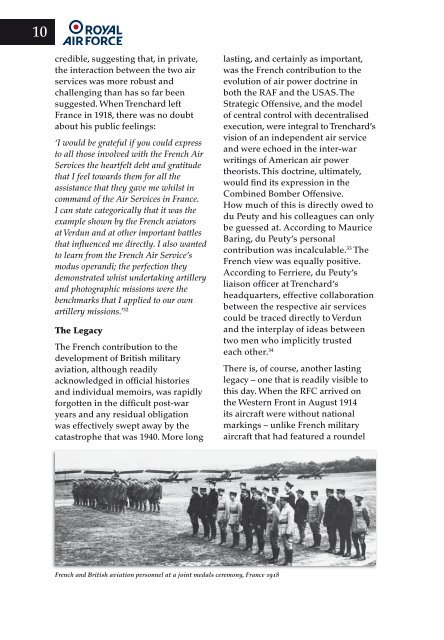You also want an ePaper? Increase the reach of your titles
YUMPU automatically turns print PDFs into web optimized ePapers that Google loves.
10<br />
credible, suggesting that, in private,<br />
the interaction between the two air<br />
services was more robust and<br />
challenging than has so far been<br />
suggested. When Trenchard left<br />
France in 1918, there was no doubt<br />
about his public feelings:<br />
‘I would be grateful if you could express<br />
to all those involved with the French <strong>Air</strong><br />
Services the heartfelt debt and gratitude<br />
that I feel towards them for all the<br />
assistance that they gave me whilst in<br />
command of the <strong>Air</strong> Services in France.<br />
I can state categorically that it was the<br />
example shown by the French aviators<br />
at Verdun and at other important battles<br />
that infl uenced me directly. I also wanted<br />
to learn from the French <strong>Air</strong> Service’s<br />
modus operandi; the perfection they<br />
demonstrated whist undertaking artillery<br />
and photographic missions were the<br />
benchmarks that I applied to our own<br />
artillery missions.’ 32<br />
The Legacy<br />
The French contribution to the<br />
development of British military<br />
aviation, although readily<br />
acknowledged in offi cial histories<br />
and individual memoirs, was rapidly<br />
forgotten in the diffi cult post-war<br />
years and any residual obligation<br />
was effectively swept away by the<br />
catastrophe that was 1940. More long<br />
lasting, and certainly as important,<br />
was the French contribution to the<br />
evolution of air power doctrine in<br />
both the RAF and the USAS. The<br />
Strategic Offensive, and the model<br />
of central control with decentralised<br />
execution, were integral to Trenchard’s<br />
vision of an independent air service<br />
and were echoed in the inter-war<br />
writings of American air power<br />
theorists. This doctrine, ultimately,<br />
would fi nd its expression in the<br />
Combined Bomber Offensive.<br />
How much of this is directly owed to<br />
du Peuty and his colleagues can only<br />
be guessed at. According to Maurice<br />
Baring, du Peuty’s personal<br />
contribution was incalculable. 33 The<br />
French view was equally positive.<br />
According to Ferriere, du Peuty’s<br />
liaison offi cer at Trenchard’s<br />
headquarters, effective collaboration<br />
between the respective air services<br />
could be traced directly to Verdun<br />
and the interplay of ideas between<br />
two men who implicitly trusted<br />
each other. 34<br />
There is, of course, another lasting<br />
legacy – one that is readily visible to<br />
this day. When the RFC arrived on<br />
the Western Front in August 1914<br />
its aircraft were without national<br />
markings – unlike French military<br />
aircraft that had featured a roundel

















